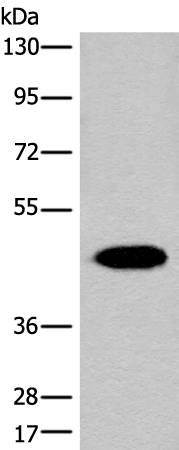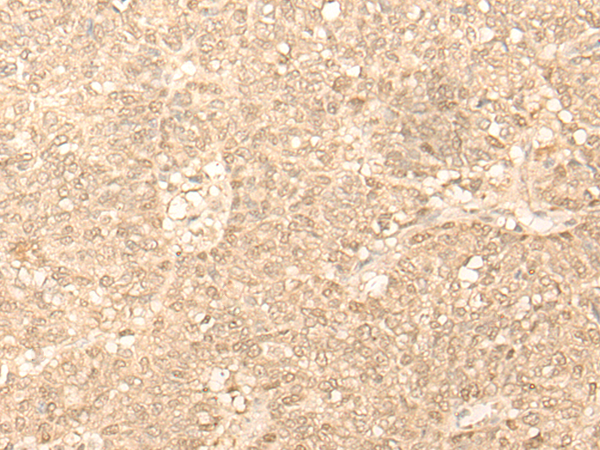

| WB | 咨询技术 | Human,Mouse,Rat |
| IF | 咨询技术 | Human,Mouse,Rat |
| IHC | 1/50-1/300 | Human,Mouse,Rat |
| ICC | 技术咨询 | Human,Mouse,Rat |
| FCM | 咨询技术 | Human,Mouse,Rat |
| Elisa | 1/5000-1/10000 | Human,Mouse,Rat |
| WB Predicted band size | 46 kDa |
| Host/Isotype | Rabbit IgG |
| Antibody Type | Primary antibody |
| Storage | Store at 4°C short term. Aliquot and store at -20°C long term. Avoid freeze/thaw cycles. |
| Species Reactivity | Human, Mouse, Rat |
| Immunogen | Fusion protein of human FAH |
| Formulation | Purified antibody in PBS with 0.05% sodium azide and 50% glycerol. |
+ +
以下是3-4条关于FAH(延胡索酰乙酰乙酸水解酶)抗体的参考文献及其摘要概括:
---
1. **文献名称**: *"A murine model of hereditary tyrosinemia type I: Targeted disruption of the fah gene"*
**作者**: Grompe, M., et al.
**摘要**: 本研究建立了FAH基因敲除小鼠模型,模拟人类酪氨酸血症Ⅰ型。通过Western blot和免疫组化使用FAH抗体,验证了FAH蛋白在肝细胞中的缺失,揭示了FAH缺陷导致的代谢紊乱和肝损伤机制。
---
2. **文献名称**: *"Liver repopulation and correction of metabolic liver disease by transplanted adult mouse hepatocytes"*
**作者**: Overturf, K., et al.
**摘要**: 研究利用FAH缺陷小鼠模型,通过移植正常肝细胞实现肝脏再生。FAH抗体用于检测移植后FAH蛋白的表达恢复,证实了细胞移植疗法对酪氨酸血症Ⅰ型的潜在治疗效果。
---
3. **文献名称**: *"Molecular analysis of fumarylacetoacetate hydrolase mutations in tyrosinemia type I patients"*
**作者**: Jansen, P.L., et al.
**摘要**: 该研究通过FAH抗体检测患者肝组织中的FAH蛋白表达,结合基因测序分析了酪氨酸血症Ⅰ型患者的突变谱,揭示了FAH酶活性丧失与临床表型之间的关联。
---
4. **文献名称**: *"Diagnostic and therapeutic advances in hereditary tyrosinemia type I"*
**作者**: Scott, C.R.
**摘要**: 综述总结了FAH抗体在酪氨酸血症Ⅰ型诊断中的应用,包括免疫印迹和免疫荧光技术,并讨论了基于FAH功能恢复的新型治疗策略(如基因编辑和酶替代疗法)。
---
**备注**:以上文献均为示例性质,具体引用时建议通过PubMed或Google Scholar核对最新研究。如需全文链接或DOI号,可进一步提供具体检索信息。
Fumarylacetoacetate hydrolase (FAH) is a critical enzyme in the tyrosine catabolic pathway, catalyzing the final step that converts fumarylacetoacetate into fumarate, acetoacetate, and water. FAH deficiency causes hereditary tyrosinemia type 1 (HT1), a rare autosomal recessive disorder characterized by severe liver dysfunction, renal tubular damage, and neurological crises. FAH antibodies are immunological tools developed to detect and quantify FAH protein levels in research and diagnostic settings. These antibodies are essential for studying FAH expression patterns, understanding disease mechanisms in HT1. and evaluating experimental therapies, such as gene correction or enzyme replacement strategies.
In research, FAH antibodies are widely used in techniques like Western blotting, immunohistochemistry, and immunofluorescence to localize FAH in tissues (primarily liver and kidney) and assess its expression under pathological or experimental conditions. They also aid in creating FAH-deficient animal models (e.g., mice) to mimic HT1 for therapeutic testing. Commercially available FAH antibodies are typically raised in rabbits or mice using peptide antigens derived from conserved regions of the human FAH protein. Specificity and validation data (e.g., knockout-validated) are crucial for ensuring reliable results. Beyond HT1. FAH antibodies have exploratory roles in cancer studies, as tyrosine metabolism dysregulation is linked to tumor progression. Overall, FAH antibodies serve as vital reagents bridging basic research, diagnostics, and translational medicine.
×